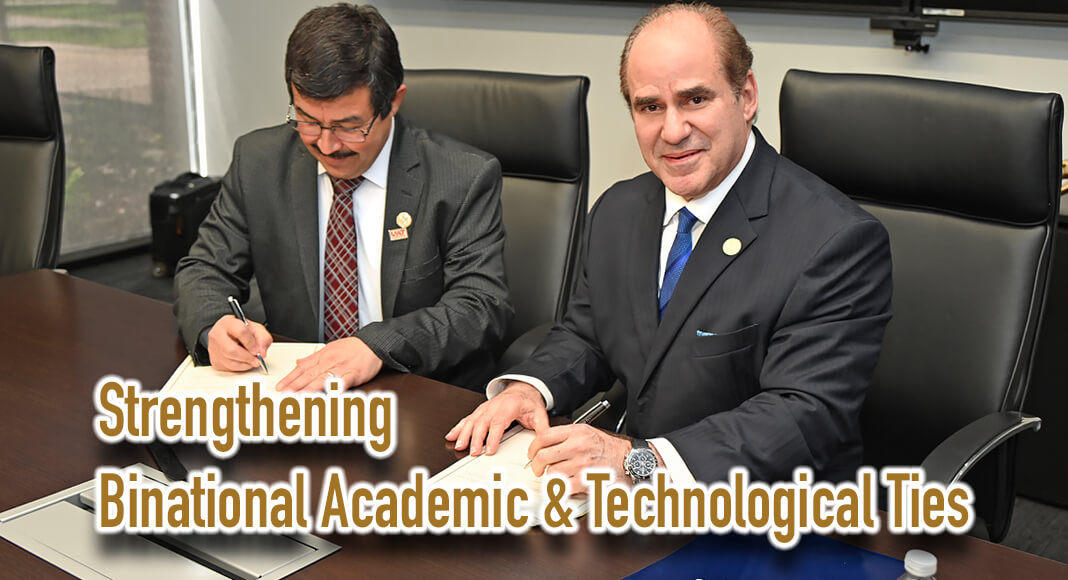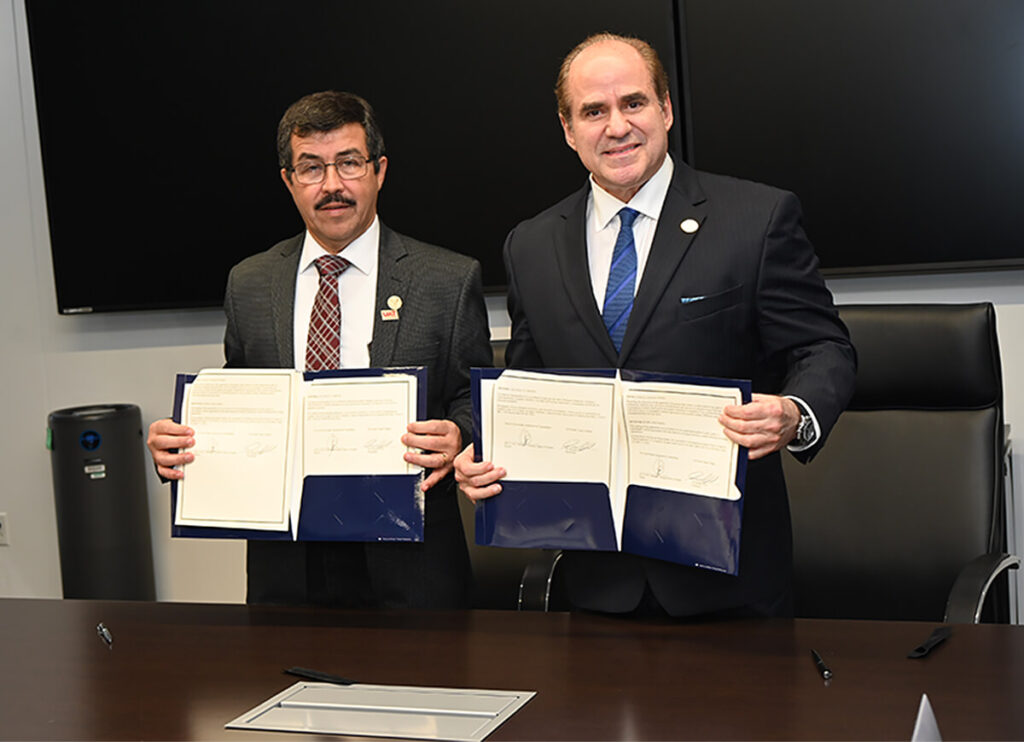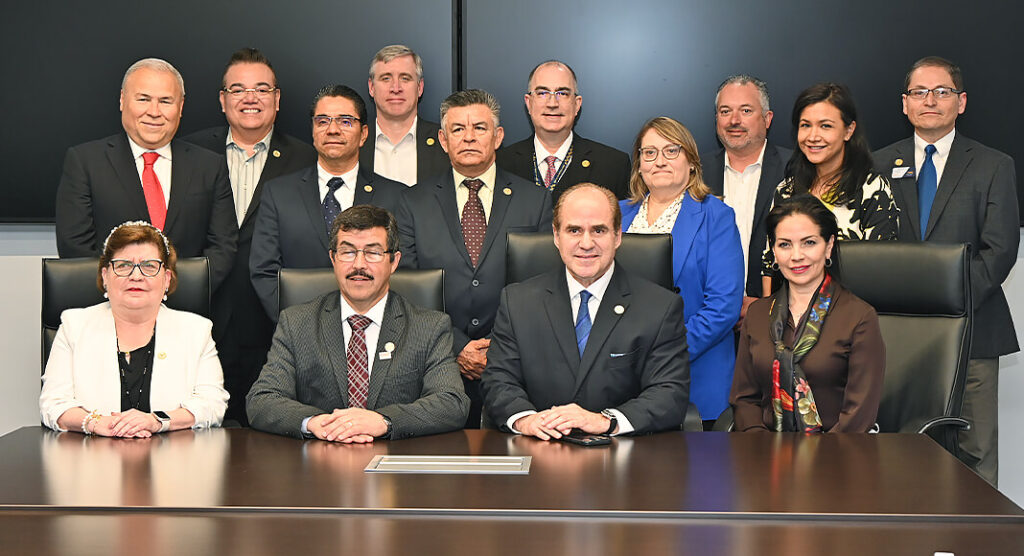
Texas Border Business
By Roberto Hugo González
In a landmark meeting held today, April 11, 2024, South Texas College, under the leadership of Dr. Ricardo Solis, hosted a significant assembly with the Rector of the Universidad Autónoma de Tamaulipas (UAT), MC. Dámaso Leonardo Anaya Alvarado and a distinguished delegation. The event, symbolizing a bridge to new frontiers in academic and technological cooperation, culminated in signing a Memorandum of Understanding (MOU), marking a milestone in cultural and technological exchange that promises to benefit both educational institutions.

Dr. Brett Jorge Millán, Associate Vice-President of Academic Advancement, highlighted the meeting as a testament to mutual collaboration towards regional prosperity, inviting those present to an official presentation to facilitate open and fruitful discussion. In an atmosphere charged with expectations and enthusiasm, Dr. Ricardo Solis expressed his desire to adopt an informal approach to promote constructive dialogue on potential areas of specific collaboration, such as continuing education, robotics, cybersecurity, and paramedic services. He highlighted the potential for growth and the importance of binational cooperation for strengthening the border region.
MC. Anaya Alvarado, recently appointed Rector of UAT, shared his vision of strengthening educational infrastructure in Tamaulipas and promoting effective synergy with the state government and other strategic partners, including academic links with Australia and the expansion of cooperation in key areas such as advanced manufacturing and cybersecurity. He emphasized the importance of this collaboration for state development and improving educational quality for UAT students, distributed across significant centers throughout the state of Tamaulipas.
The meeting concluded with a call to action by Dr. Solis, who urged attendees to actively participate in the discussion to identify concrete opportunities for collaboration, laying the groundwork for a lasting and mutually beneficial partnership between South Texas College, UAT, and Texas A&M, as well as with the support of the Mexican Consulate and local leaders, reaffirming the commitment to advancing education and technology in the border region.
The mayor of McAllen, Javier Villalobos, extended a warm welcome to the UAT committee, highlighting the pleasure of collaborating with prominent figures such as Manuel Vela, Dr. Solis, and Consul Froylan. He stressed the unique synergy that has emerged since Dr. Solis’s arrival, driving unprecedented growth in the region.

Villalobos highlighted the dynamism of cooperation between Texas A&M, STC, other educational institutions, and the cities, emphasizing the positive transformation of the area. A visit to a school in Matamoros, Mexico, with Dr. Solis was mentioned as an example of the constant effort to work together not only as a region encompassing southern Texas and northern Mexico, including Tamaulipas but as a strategic point between two powerful nations.
This approach not only redefines the perception of the area as merely borderland but as a key neuralgic center, especially relevant in the context of nearshoring. Villalobos insisted on the need for educated human capital as the cornerstone for regional success, expressing optimism and gratitude for the collaboration and anticipating future successes thanks to these strategic alliances.
Manuel Vela, Vice President of Texas A&M in McAllen, Texas, shared his perspective on the strategic choice of this location, emphasizing the importance of looking beyond state borders for broader collaboration with Mexico. He echoed the words of Texas A&M Chancellor John Sharp, who highlights that Texas’s fate is intrinsically linked to that of southern Texas and, by extension, to Mexico. Vela highlighted the vision of building relationships that benefit both local communities and those in neighboring states of Mexico, expressing interest in exploring and understanding the opportunities presented to foster these essential partnerships.
His speech’s key points were the valuation of the partnership with South Texas College (STC) and the potential collaboration with other institutions. Acknowledging Dr. Solis’s efforts and STC’s positive impact on the region, Vela illustrated the importance of working together to maximize the collective impact. Furthermore, he expressed deep respect for Mexico and the importance of fostering a bicultural relationship between southern Texas and northern Mexico, which he considers vital for joint development and the well-being of communities on both sides of the border. The shared vision of cross-border collaboration proposed by Vela and the mayor proves Texas A&M’s commitment to the region and its future.
Dr. Millán emphasized the diversity and breadth of his institution’s educational offerings, highlighting Dr. Solís’s previous mention of the extensive network of campuses within the system. “As you can see, Dr. Solís has already emphasized that we are part of a system composed of various campuses, through which we offer a wide range of 130 different educational programs. Most of these programs are focused on technical areas and diplomas; however, we also have academic options designed to be transferable to other universities. Additionally, we are distinguished by offering five bachelor’s degree programs, which places us among the first three institutions of our kind to be granted the right to award such degrees by law. It’s an achievement of which we are particularly proud,” Dr. Millán expressed emphatically, reflecting the institution’s commitment to excellence and versatility in higher education.
During this meeting, Dr. Ricardo Solís and UAT Rector Dámaso Leonardo Anaya Alvarado launched a groundbreaking collaborative effort to bolster Mexico-US binational ties through education and tech innovation. Highlighting this as a historic step, Dr. Solís was enthusiastic about the partnership between Universidad Autónoma de Tamaulipas (UAT), South Texas College (STC), and potentially Texas A&M, emphasizing it as pivotal for the educational sector’s binational focus.
Dr. Fernando Leal Ríos and Dr. Rosa Issel Acosta González emphasized the importance of collaborative efforts between educational institutions for innovation and growth, especially in robotics and nursing. Dr. Leal Ríos highlighted his university’s achievements and the potential for collaborative programs and research to impact the northern border region. He also discussed leveraging technology to facilitate cross-institutional work and overcoming geographic barriers. Student mobility and English training were key to fostering mutual understanding and collaborative success.
Dr. Acosta González, from UAT, underscored the university’s commitment to enhancing student development through cross-border collaborations, aiming to boost student competencies for successful careers. She also highlighted the professional development of UAT’s faculty, emphasizing the importance of overseas experiences in broadening academic perspectives and enhancing educational quality. These efforts align with UAT’s goals of fostering innovation and preparing professionals with a humanistic and technologically adept outlook.














